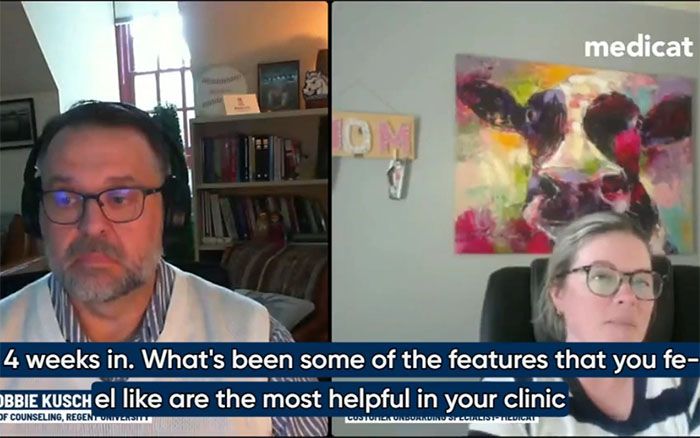Eating Disorders on Campus
What We Get Wrong (and How to Do Better)
Eating disorders are among the most misunderstood and often overlooked health challenges on college campuses. Despite growing awareness of student mental health, many institutions still struggle to identify and support those at risk before crises arise.
In this webinar recap of insights from Dr. Joanne Clinch (University of Tennessee, Knoxville) and Dr. Dani Gonzales (University of Southern California), we’ll explore the common misconceptions that hinder effective care and outline practical strategies to strengthen early intervention, coordination, and recovery support on campus.
P.S. You can view the full conversation here.
The misconceptions holding campuses back
Several persistent myths continue to shape how colleges perceive and respond to eating disorders.
Common misconceptions include beliefs that eating disorders:
- Only affects thin students
- Primarily impacts women
- They are rare or nonexistent on their campus
However, new multi-campus research from Washington University in St. Louis (spanning 29,951 students across 26 institutions, published in early 2025) challenges all three. The study found that risk levels were comparable across racial and ethnic groups, including white, Black, Asian, and Latino students—though prevalence varied by diagnosis subtype.
Importantly, two-thirds of survey participants identified as female, reflecting long-standing sampling biases rather than the true scope of the issue. These findings reinforce what campus health and counseling leaders increasingly observe: eating disorders can affect any student, regardless of body type, gender, race, or background.
Bottom line: You can’t “see” an eating disorder. Students of any size, gender identity, or background may be affected. National organizations echo the same message and call for more inclusive research and screening.
What challenges are students really facing
Both Dr. Clinch and Dr. Gonzales emphasized that campus teams diagnose anorexia nervosa most often while under-detecting bulimia nervosa, binge eating disorder, atypical anorexia, and ARFID. For instance:
- Students frequently present for anxiety, depression, sleep issues, or academic stress—not for “eating problems.” Gentle screening questions about eating, movement, sleep, and coping skills can reveal risks earlier.
- Co-occurring mental health concerns are common; depressive symptoms are particularly prevalent among students screening positive for eating disorders, reinforcing the need for integrated physical and mental health care.
This reinforces a strategic point: early identification and coordinated response keep students enrolled and supported academically.
Screening tools that fit higher ed
There’s no one perfect screener, but both Dr. Clinch and Dr. Gonzales highlighted pragmatic options:
- EDE-QS (12 items, past 7 days): quick to administer and useful for baseline and progress checks during a semester. Pair scores with clinical judgment to avoid over-/under-interpretation.
- SBIRT-ED for Eating Disorders (UNC/NCEED): a screening–brief intervention–referral model with built-in language for providers and direct links to care resources. This tool may be ideal for primary care settings on campus.
Tip for clinics: Add a structured ED screener to intake appointments and repeat around midterms/finals, when stress spikes. Track outcomes across the term to inform staffing and referral strategy.
ARFID on campus: what’s different in adults
Clinically, both Dr. Clinch and Dr. Gonzales are seeing more average-to-higher-weight students with narrow safe-food lists, sensory sensitivities, and significant dining-hall challenges—often without classic pediatric malnutrition profiles. These types of students often have an ARFID diagnosis.
Furthermore, partnering closely with the Registered Dieticians on your campus is essential to map dining options, coordinate accommodations, and plan step-downs from higher levels of care.
Building a campus model that works
You don’t need a full specialty program to improve care for eating disorders on campus meaningfully. Dr. Clinch and Dr. Gonzales shared a roadmap any institution can adapt:
1) Stand up a multidisciplinary case review
Create a standing one-hour huddle (primary care, counseling, psychiatry, RDs, case management). Focus on risk review, shared decisions, and clear treatment agreements that define your center’s scope and thresholds for step-up care.
2) Normalize screening beyond counseling
Train medical providers to spot physical “clues”:
- GI complaints
- Syncope
- Amenorrhea/cycle irregularities
- Unexplained weight change
- And to avoid congratulating weight loss—ask about context and functioning first.
3) Strengthen off-campus referral rails
Curate a rapid-access referral network (IOP/PHP/residential) and establish ROI templates for warm hand-offs and returns from leave (aligning with Dean of Students/Campus Support offices).
4) Address culture, not just cases
Collaborate with Campus Recreation teams on weight-neutral messaging and training for fitness staff; partner with LGBTQIA+ centers, student cultural organizations, dance programs, and NAMI chapters to deliver subclinical prevention and body-image programming.
For instance, national tools like NEDA Campus Warriors can help student leaders get others involved.
5) Invest in ongoing training
Point staff to NCEED and for free/low-cost provider education and campus-oriented resources.
Technology that lightens the lift
Technology can operationalize the model above:
- Secure messaging & telehealth: Send post-visit resources (e.g., breathing exercises, nutrition-focused education videos), conduct quick check-ins, and maintain continuity during leaves or travel.
- Risk dashboards & permissions: Track historical risk levels, coordinate care across teams, and protect privacy with granular system access.
Key Takeaways
Eating disorders on campus are more widespread and more diverse than many assume—and they’re treatable when identified early. A practical blend of inclusive screening, brief interventions, coordinated referrals, and stigma-reducing culture change can keep more students safe, well, and enrolled.
























